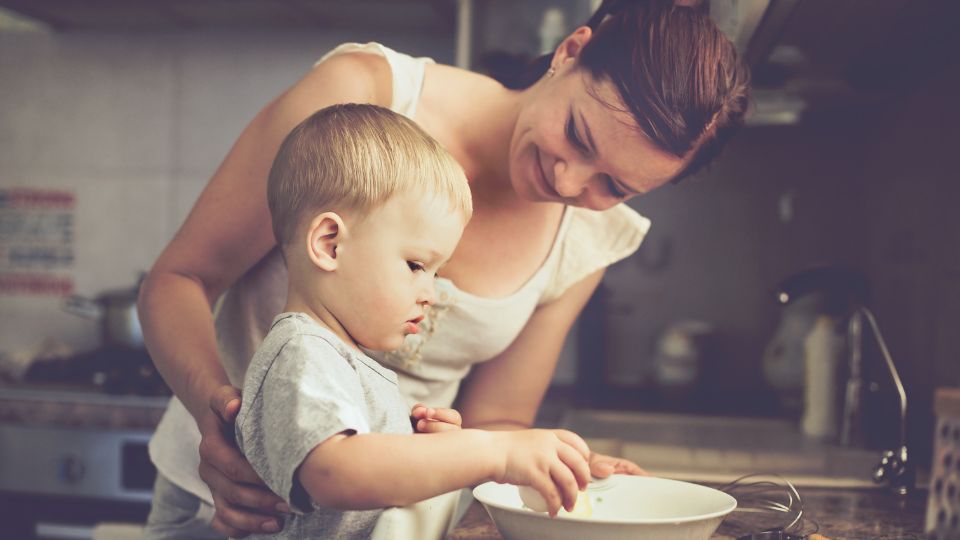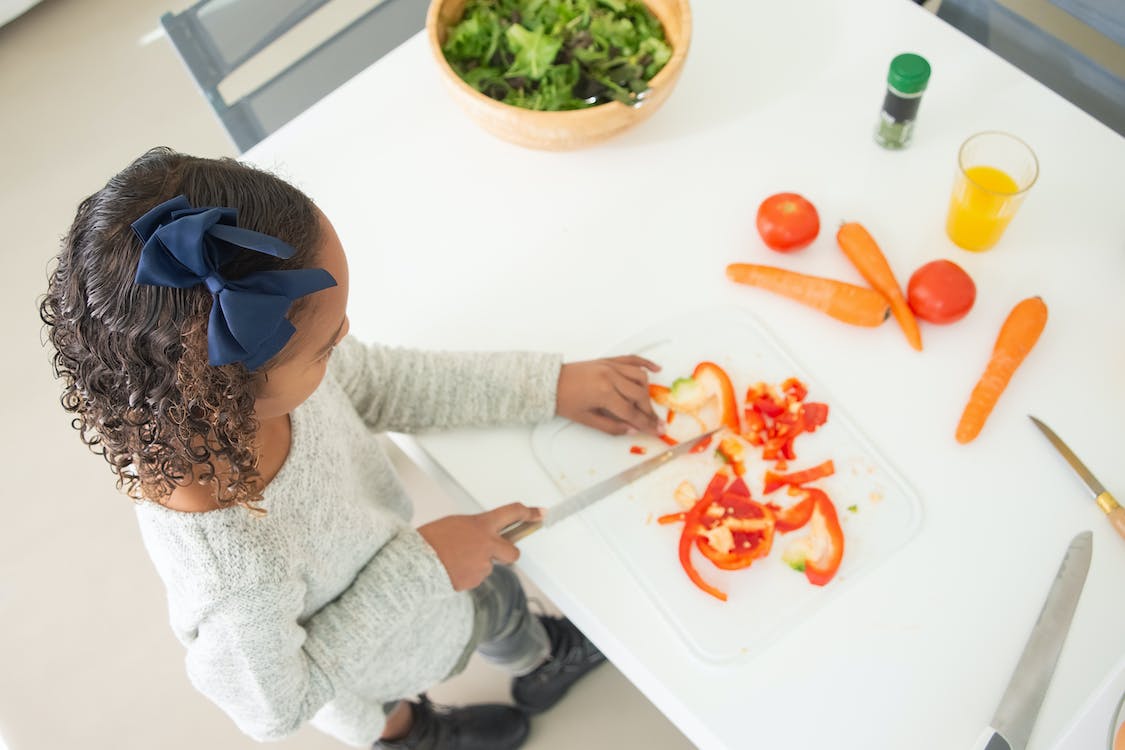The Benefits of Including Kids in the Kitchen

Learning to cook is an essential life skill everyone should strive to develop at some point in their life. Involving kids in the kitchen is a great way to kickstart that learning from a young age and comes with numerous benefits. Cooking with kids provides opportunities to teach them about food and nutrition. Involvement in meal preparation exposes them to new foods in a positive way and increases their likelihood of trying new foods, such as fruits and vegetables (van der Horst et al., 2014). Consequently, getting your kids cooking may be a great way to raise less picky and more adventurous eaters. The purpose of this fact sheet is to explore the benefits of cooking with children and provide some helpful tips to get started.
Encourage Adventurous Eating

Cooking with children is a great way to encourage them to try new foods, especially ones they are initially unsure about. As kids try new foods, parents can encourage them to use all their senses such as smelling, feeling, and tasting a sample and discuss the differences the children notice. When children are able to get comfortable with a new food before eating it, they are more likely to have a positive perception of it, and more likely to eat it (Ng et al., 2021). This may be an effective strategy to use with picky eaters because children tend to be more willing to try the foods they have helped prepare (Quelly, 2019). Children are also more likely to consume foods from all the food groups when they are involved in cooking (Nozue et al., 2016).
Increase Veggie Consumption
Over 90% of children in the United States aged 2-18 years consume less than the recommended servings of vegetables each day (Kim et al., 2014). Getting kids to eat their veggies can be a tricky task, especially for picky eaters. Unfortunately, if kids feel pressured to try new foods such as vegetables, there is an increased chance they will avoid that food (DeCosta et al., 2017). Including children in the cooking process is a good strategy without any pressuring or nagging, as children who are involved in cooking are more likely to eat raw and cooked veggies at mealtime (Garcia et al., 2020). Try letting kids choose which vegetable to make for the meal and see if it increases their interest in eating it even more. In fact, kids who regularly help with mealtime preparation tend to eat an additional serving of veggies every day compared to kids who don’t (Chu et al., 2014). Simply getting kids involved in food preparation has healthy dietary benefits beyond just increasing children’s willingness to eat more fruits and veggies such as decreasing risk for nutritional deficiency and having higher quality diets overall (Quelly, 2019). This can be an easy way to increase their consumption of healthy foods, while spending time together in the process. Sounds like a win-win, right?
Raising Smart Kids
There are so many important skills that can be learned in the kitchen. The American Academy of Pediatrics encourages using cooking time to teach kids about counting, fractions, measuring, science, vocabulary, and how to follow directions (Fernando, 2020). Many of these skills are naturally developed when cooking, and this is a great time to incorporate learning. Helping children develop these cooking skills also increases their confidence in their ability to cook and make healthy decisions (Asigbee et al., 2020). Parents can also teach their kids about where ingredients came from, how they were grown, if it is a plantbased food, and which part of the plant it is from (root, stem, flower, or fruit). Children may also enjoy learning about what labels on ingredients mean and the nutritional benefits whole foods have on their growing bodies. Meal preparation can be a great time to start talking about nutrition. Incorporating different food groups for building balanced meals and food safety are more possible topics of conversation that could easily be incorporated into cooking time.

Where to Start
You can begin involving your children in the kitchen as young as two years old, with the most simple and safe tasks, as long as they can follow simple directions (Dean et al., 2021). Teach children to wash their hands for 20 seconds and clean counter spaces before preparing food. As their motor skills improve, new skills can be taught. Slow progression of tasks allows children to participate in the meal preparation process while also keeping them safe. Progression with chopping could be starting with a plastic knife and soft food, and progressing to a real knife as their skills, technique, and confidence increase (Dean et al., 2021). Safety and supervision are crucial and should always be considered when introducing new skills. The Academy of Nutrition and Dietetics has cooking suggestions for different age groups, which can be found along with more ideas in Table 1. Keep in mind that there are many other ways you can involve your kids in the kitchen that may not be listed, and some tasks may be done at an earlier age with some extra assistance or modification.
Table 1. Kid-Friendly Cooking Tasks by Age Groups
| Age group | Appropriate tasks |
|---|---|
| 3-5 years old |
|
| 6-7 years old |
|
| 8-9 years old |
|
| 10+ years old |
|
Try getting your kids involved in the kitchen next time you are cooking a meal! It can be a great opportunity to spend quality time together and teach them valuable skills and knowledge at the same time. Raising confident, adventurous cooks and eaters may be easier than you think!
References
- Asigbee, F. M., Davis, J. N., Markowitz, A. K., Landry, M. J., Vandyousefi, S., Ghaddar, R., Ranjit, N., Warren, J., & van den Berg, A. (2020). The association between child cooking involvement in food preparation and fruit and vegetable intake in a hispanic youth population. Current Developments in Nutrition, 4(4). https://doi.org/10.1093/cdn/nzaa028
- Chu, Y. L., Storey, K. E., & Veugelers, P. J. (2014). Involvement in meal preparation at home is associated with better diet quality among canadian children. Journal of Nutrition Education and Behavior, 46(4), 304–308 . https://doi.org/10.1016/j.jneb.2013.10.003
- Dean, M., O’Kane, C., Issartel, J., McCloat, A., Mooney, E., Gaul, D., Wolfson, J. A., & Lavelle, F. (2021). Guidelines for designing age-appropriate cooking interventions for children: The development of evidence-based cooking skill recommendations for children, using a multidisciplinary approach. Appetite, 161 . https://doi.org/10.1016/j.appet.2021.105125
- DeCosta, P., Møller, P., Frøst, M. B., & Olsen, A. (2017). Changing children’s eating behaviour—A review of experimental research. Appetite, 113, 327–357. https://doi.org/10.1016/j.appet.2017.03.004
- Fernando, N. (2020, 11). 5 great reasons to cook with your kids. HealthyChildren.Org. https://www.healthychildren.org/English/healthy-living/nutrition/Pages/Cooking-WithYour-Children.aspx
- Garcia, A. L., Brown, E., Goodale, T., McLachlan, M., & Parrett, A. (2020). A nursery-based cooking skills programme with parents and children reduced food fussiness and increased willingness to try vegetables: A quasi-experimental study. Nutrients, 12(9), 2623. https://doi.org/10.3390/nu12092623
- Kim, S. A., Moore, L. V., Galuska, D., Wright, A. P., Harris, D., Grummer-Strawn, L. M., Merlo, C. L., Nihiser, A. J., Rhodes, D. G. (2014). Vital Signs: Fruit and vegetable intake among children—United States, 2003–2010. Morbidity and Mortality Weekly Report (MMWR), 63, 671–676.
- Ng, C. M., Kaur, S., Koo, H. C., & Mukhtar, F. (2021). Involvement of children in hands-on meal preparation and the associated nutrition outcomes: A scoping review. Journal of Human Nutrition and Dietetics , 35(2), 350-362. https://doi.org/10.1111/jhn.12911
- Nozue, M., Ishida, H., Hazano, S., Nakanishi, A., Yamamoto, T., Abe, A., Nishi, N., Yokoyama, T., & Murayama, N. (2016). Associations between Japanese schoolchildren’s involvement in at-home meal preparation, their food intakes, and cooking skills. Nutrition Research and Practice, 10(3), 359–363. https://doi.org/10.4162/nrp.2016.10.3.359
- Quelly, S. B. (2019). Helping with meal preparation and children’s dietary intake: A literature review. The Journal of School Nursing, 35(1), 51–60. https://doi.org/10.1177/1059840518781235
- The Academy of Nutrition and Dietetics. (2019, February). Teaching kids to cook . Eatright.Org. https://www.eatright.org/homefoodsafety/four-steps/cook/teaching-kids-tocook
- van der Horst, K., Ferrage, A., & Rytz, A. (2014). Involving children in meal preparation. Effects on food intake. Appetite, 79, 18–24 . https://doi.org/10.1016/j.appet.2014.03.030
Published September 2022
Utah State University Extension
Peer-reviewed fact sheet
Authors
Cloie Malan, dietetics student; Stacy Bevan MS, RD; Mateja R. Savoie-Roskos PhD, MPH, RD

